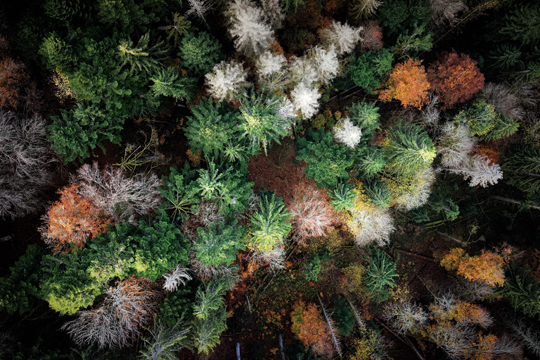It’s the mix that counts
Freiburg, Oct 14, 2020
While hikers want to relax, forestry companies seek to produce raw materials and conservationists want to preserve the local biodiversity. The demands on the forest are diverse and sometimes contradictory. In celebration of the 50th anniversary of the Faculty of Environment and Natural Resources (UNR), a series of articles presents its various departments and research projects. The fifth part - Forest - deals with the question of whether and how the different demands can be balanced and what role the design of the forests plays in it all.
 Among other things, the researchers study the growth, rooting and mortality of trees. Photo: Julian Frey
Among other things, the researchers study the growth, rooting and mortality of trees. Photo: Julian Frey
How must forests be structured so that they can sustainably provide their ecosystem services - such as timber production or carbon and water storage in the face of conflicting and diverse needs? How can prudent silviculture mitigate negative effects of climate change? In order to find answers to these questions, Prof. Dr. Jürgen Bauhus is working with experts in soil science, remote sensing and ecology, among others, and is investigating forests and management systems around the globe, be it the Mooswald in the city of Freiburg or an area in China.
With his 20-member team, the forestry scientist is closely involved in the activities of the UNR faculty and is well networked both regionally and internationally. For example, the scientists cooperate with the Forest Research Institute Baden-Württemberg, are involved with partners from France and Switzerland in the NFZ.forestnet network and are part of interdisciplinary projects in Germany and abroad. At the same time, they implement their own experiments on site. Sometimes they take place in the forests of the city of Freiburg, sometimes Bauhus sets up its own field trial areas for them.
More species mean more biomass
In 2013, for example, when various university working groups jointly planted almost 20,000 trees on an area of one and a half hectares near Freiburg Airport. The aim was to compare biomass growth and other ecosystem processes between mixed forests and monocultures and to investigate the climate suitability of different tree species at the same location. For this purpose, plots with monocultures containing spruce, pine, larch, oak, birch and maple as well as plots with an increasing mixture of up to six species of these hardwoods and softwoods were created. Over the past seven years, researchers have measured height and diameter growth, mortality, rooting and many other variables. The data show that in mixed forests, trees produce more biomass compared to monocultures. The results of an experiment from China, in which Bauhus is involved, support the Freiburg results.
With regard to the effects of climate change, the forestry scientist was also able to prove that mixed forests are in many cases more resistant to drought stress and can recover from it more quickly than monocultures. These properties also apply to trees from forests that are intensively thinned. “If about a quarter of the stock is regularly harvested at intervals of five to ten years, the remaining trees have more resources such as soil water at their disposal, which means that their roots and leaves regenerate more quickly after acute drought,” the expert explains.
Within the interdisciplinary research training group ConFoBi, Bauhus and two doctoral students are also investigating how trees as habitats in an experimental region in the Black Forest can contribute to the preservation and protection of biodiversity. Some of the so-called habitat trees, for example, have dead branches in tree crowns or putrid cavities in the trunk. These spaces are of particular importance for bats and insects. The graduate school is scheduled to run for nine years, and in the next phase of the project will increasingly produce syntheses using the diverse data collected so far.
Drill cores illustrate water shortage
The forest ecosystem can reach its limits due to climatic stress and the fulfillment of economic and social demands, especially if the natural balance is disturbed. One example is the groundwater extraction in Freiburg’s Mooswald and other oak forests of the Rhine valley to supply industry, agriculture and private households. In order to understand how this affects trees in hot summers, Bauhus’ working group took cores from oak trunks and examined them for drought stress. He concluded that the narrower annual rings in times of double stress show that the use of groundwater slows down the growth of the oaks, makes it difficult for them to recover from droughts and thus increases their mortality.
“There are many conflicts of interest,” admits the scientist. “In order to solve them, it is above all important to maintain functioning ecosystems in times of climate change, which can meet many different demands.” This includes, for example, cultivating tree species from other continents or from warmer and drier regions in Europe. In addition to the suitability of the trees, societal acceptance is also important in these steps, says the researcher. “A conservative approach to nature conservation and concern about the loss of traditional tree species are currently fostering an emotionally charged debate on the cultivation of new or non-indigenous tree species.”
In the end, the decision is based on weighing up the various values, emphasizes Jürgen Bauhus. “Either people accept non-native species in favor of the stability of the ecosystem, or they stick with local, non-adaptive tree species with all the negative consequences for organisms dependent on them. There is not always an optimal solution.” The scientist also contributes his expertise to policy-making at the federal and state levels by analyzing the advantages and disadvantages of various courses of action and helping to create a better basis for decision-making.
Kristin Schwarz
More articles from this series:
Water shortages lead to heightened conflicts

